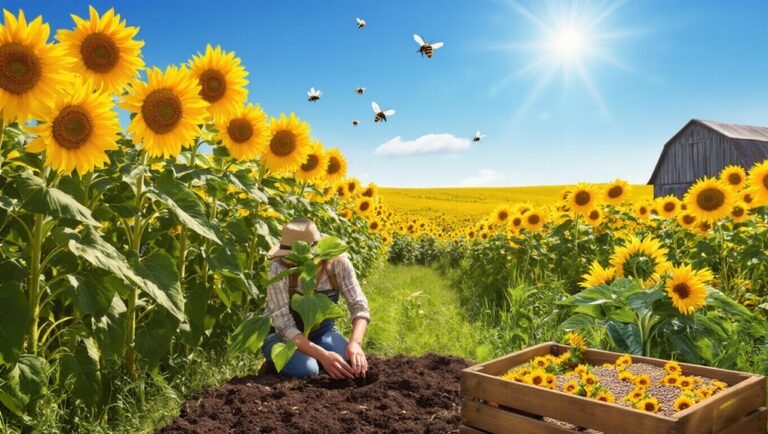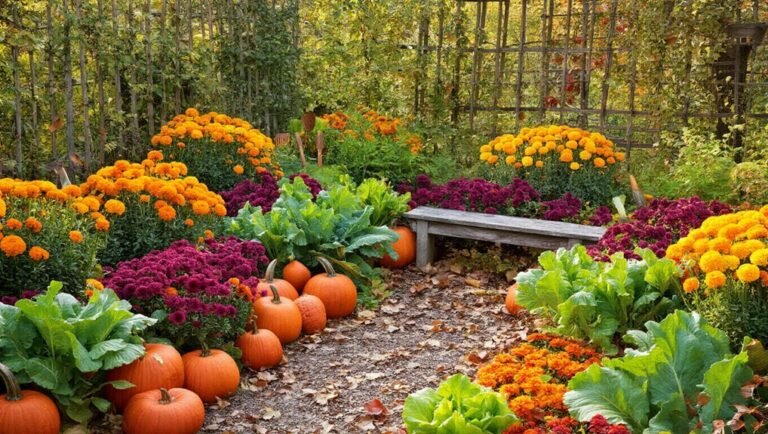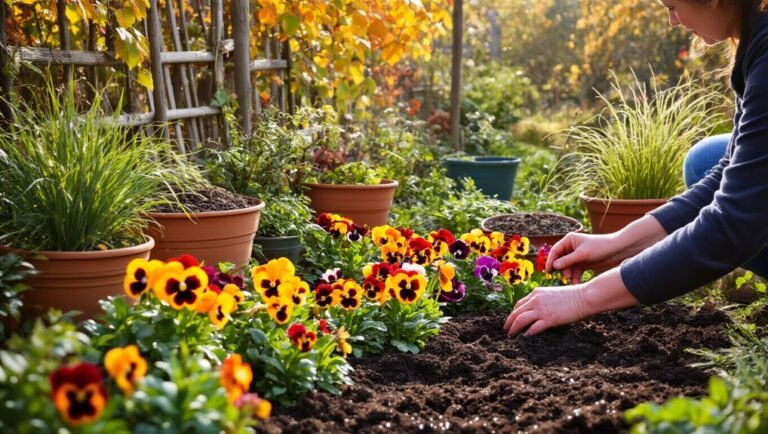Creating a stunning flower garden starts with assessing your space and understanding your climate and soil. Check for sunlight, obstructions, and soil type to choose the right flowers that thrive in your conditions. Plan your layout to avoid overcrowding and incorporate different bloom times for year-round interest. Don’t forget maintenance tips like proper spacing and deadheading. As you explore these essential steps, you’ll discover even more ways to elevate your garden’s beauty.
Key Takeaways
- Assess sunlight exposure and check for obstructions to ensure optimal flower growth and visibility.
- Determine climate and soil type to select suitable plants that thrive in your garden conditions.
- Plan a diverse palette of annuals and perennials for color and seasonal interest throughout the year.
- Design your layout with attention to plant height, color grouping, and pathways for easy navigation.
- Implement regular maintenance practices, including deadheading and pest checks, for a flourishing flower garden.
Assessing Your Garden Space
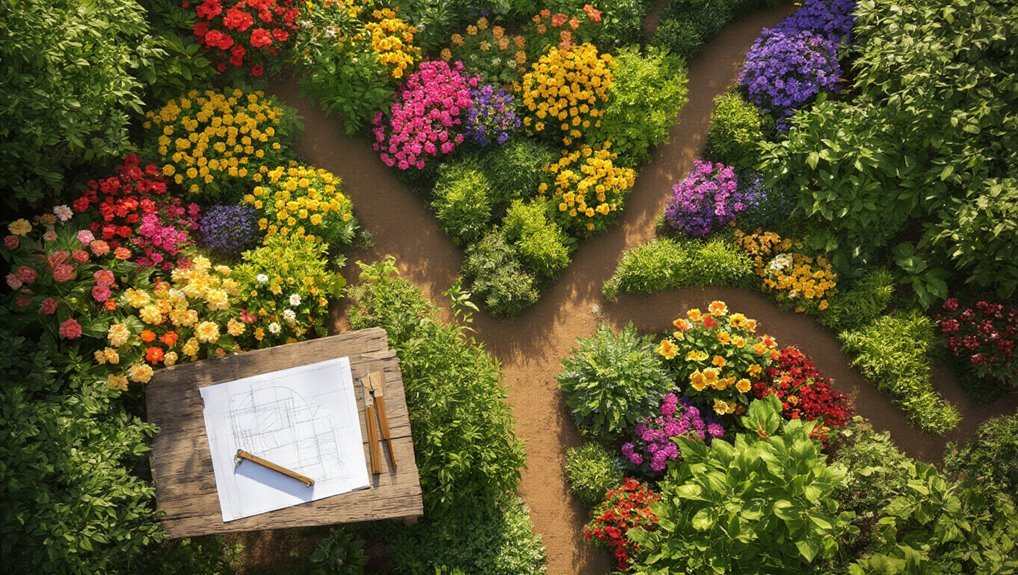
Before you dive into planting, take a moment to assess your garden space.
Look at the sunlight exposure throughout the day; most flowers need at least six hours of direct sunlight. Check for any obstructions, like trees or buildings, that may cast shadows. A key tool for ensuring your new plants get the right amount of moisture is a watering can, which can help provide even and gentle watering to delicate seedlings.
Next, evaluate the layout—consider the shape and size of your area. This will help you determine how many plants can fit comfortably without overcrowding.
Also, think about visibility; you want your blooms to be seen and appreciated.
Finally, take note of any existing plants or structures that could influence your design.
When you’re ready to start working the soil, having the perfect garden trowel will make planting and maintenance much easier.
Understanding Your Climate and Soil
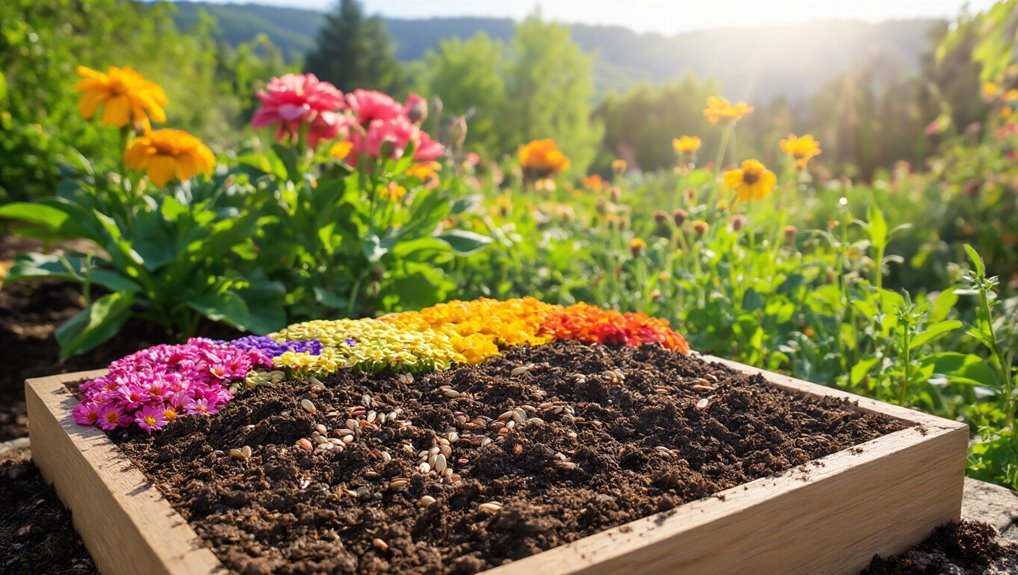
Understanding your climate and soil is crucial for selecting the right flowers for your garden. Start by determining your hardiness zone, which will guide you in choosing plants that thrive in your area’s temperature range.
Next, assess your soil type—whether it’s sandy, clay, or loamy—since each type affects drainage and nutrient availability. Conduct a soil test to check for pH levels and nutrient content; this will help you amend your soil effectively. Incorporating organic mulching materials like straw can also help improve soil moisture retention and suppress weeds.
Don’t forget to observe sunlight exposure throughout the day, as some flowers prefer full sun while others thrive in partial shade.
For best results, consider using the best garden soil to provide essential nutrients and support healthy plant growth in your flower beds.
By understanding these factors, you’ll create a flourishing garden that suits your specific environment and conditions.
Happy gardening!
Choosing the Right Flowers
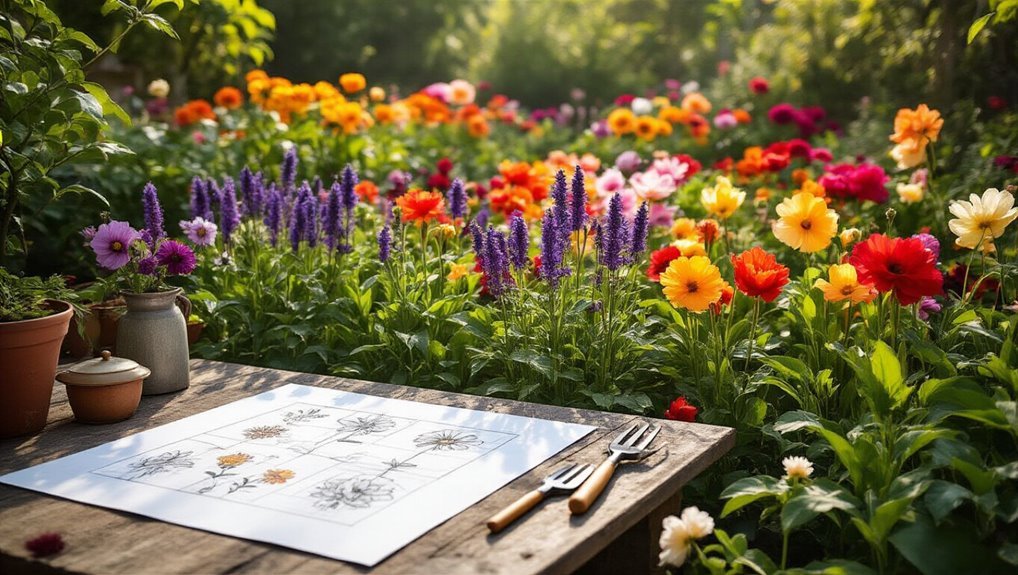
With a solid grasp of your climate and soil, you’re ready to choose the right flowers for your garden. Start by selecting flowers that thrive in your specific conditions.
Consider annuals for vibrant, short-term blooms or perennials for lasting beauty year after year. Think about color combinations that complement each other and the overall aesthetic you want to achieve. For added benefit, include insect repellent plants in your selection to help naturally deter garden pests.
Don’t forget to select flowers that attract pollinators, like bees and butterflies, enhancing both your garden’s beauty and local ecology.
Additionally, pay attention to the height and spread of your chosen flowers to ensure they fit well together.
For a unique and flavorful addition, consider planting Edible Flower Seeds to enjoy both visual appeal and culinary possibilities in your garden.
Designing Your Flower Garden Layout
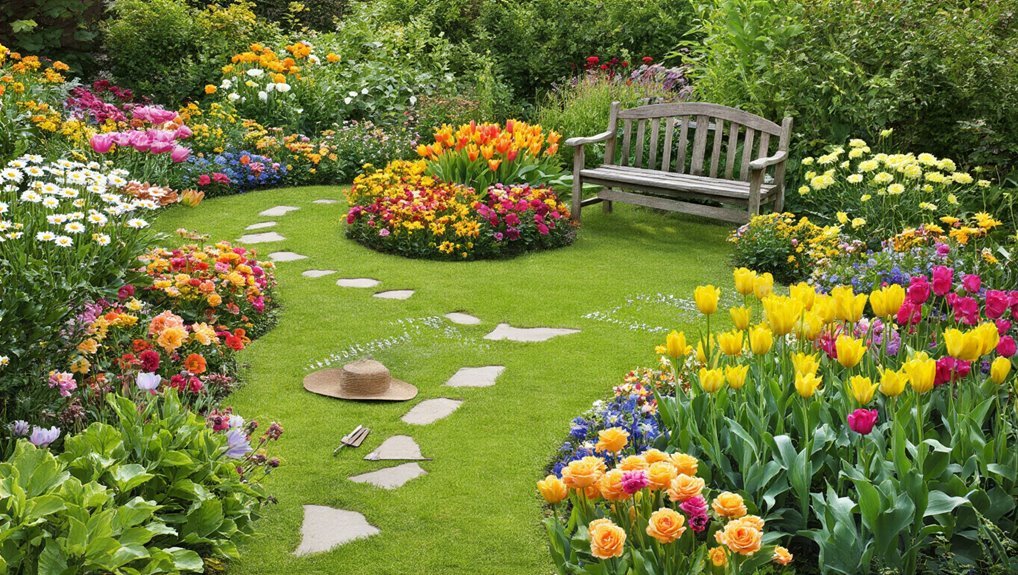
As you dive into designing your flower garden layout, consider how different elements will work together to create a harmonious space.
Start by sketching a rough plan, noting sun and shade areas to place flowers according to their light needs. Group plants with similar heights and colors to enhance visual appeal. Incorporating beautiful trellises into your garden design adds vertical interest and can support climbing plants for an extra layer of charm.
Use pathways to guide visitors through your garden, allowing them to appreciate each bloom. Think about focal points, such as a vibrant flower bed or an eye-catching sculpture, to draw attention.
Don’t forget about seasonal interest; mix early bloomers with late-season flowers.
For added structure and improved soil conditions, consider incorporating raised garden beds into your design to elevate both the appearance and productivity of your flower garden.
Lastly, leave some space for creativity and spontaneity—flowers can change your garden’s character, so embrace the unexpected as it unfolds!
Planting and Maintenance Tips
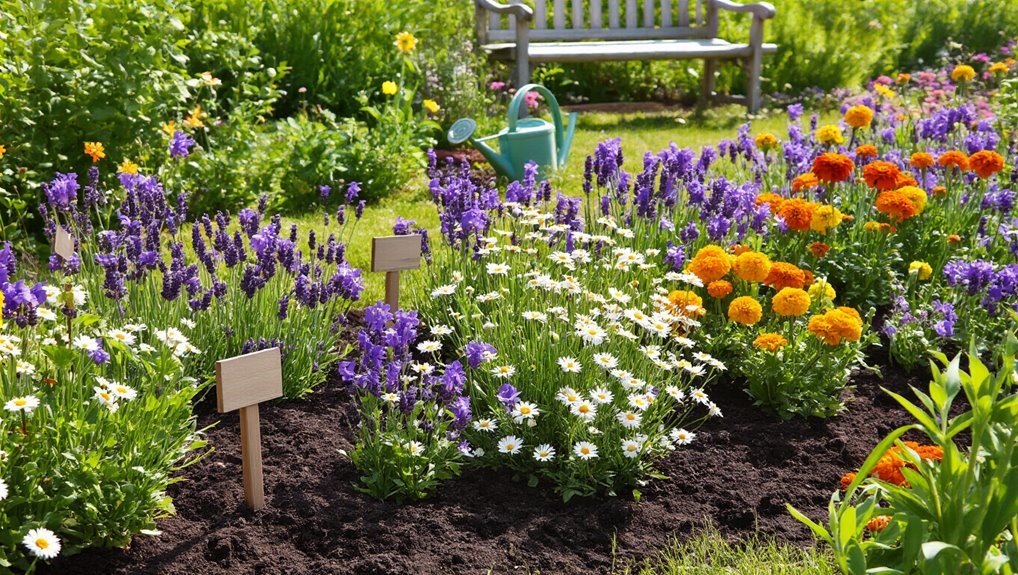
Get your hands dirty and prepare for the rewarding process of planting and maintaining your flower garden. Start by choosing the right time to plant, usually in the spring or fall, depending on your climate.
Dig well-draining soil, and mix in compost to enrich it. Adding compost bins to your garden routine ensures you have a steady supply of nutrient-rich compost for healthier plants. When planting, space your flowers according to their needs; overcrowding can hinder growth. Water them thoroughly after planting, but avoid overwatering.
Regular maintenance is key. Deadhead spent blooms to encourage new growth and keep your garden tidy.
Check for pests and diseases, treating them promptly with organic solutions. Mulch around your plants to retain moisture and suppress weeds.
For best results when starting your garden, consider using seed starting kits to ensure strong and healthy seedlings. With consistent care, your garden will flourish, bringing beauty and joy throughout the seasons.
Adding Decorative Elements and Accessories
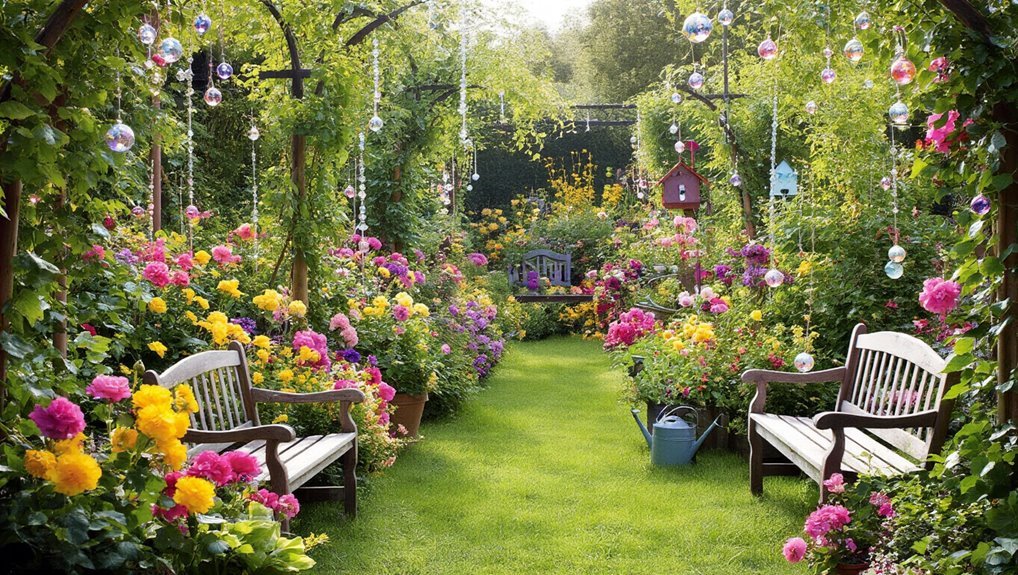
A few well-chosen decorative elements can transform your flower garden into a captivating oasis.
Start by adding a charming birdbath or a rustic bench, which invites relaxation and enjoyment. Incorporate colorful garden stakes or whimsical sculptures to bring personality and a touch of fun. You can further enrich your garden’s design with decorative garden stones, which add texture and visual interest while seamlessly blending with natural elements.
Consider using trellises or arbors to support climbing plants and create vertical interest. Pathways lined with decorative stones or mulch can guide visitors while enhancing the overall design.
Don’t forget to light up your garden with solar-powered lanterns or fairy lights for enchanting evening strolls.
Finally, adding pots or raised beds with herbs or seasonal flowers can provide additional layers and textures, making your garden not just visually appealing but also functional.
For an extra touch of charm and to attract feathered friends, consider including decorative birdhouses for gardens as part of your garden decor.
Frequently Asked Questions
How Do I Attract Pollinators to My Flower Garden?
To attract pollinators, plant a variety of native flowers, avoid pesticides, and create a welcoming habitat. Group similar blooms together, ensure there’s water nearby, and provide shelter. You’ll see bees and butterflies flocking to your garden!
What Are the Best Flowers for Beginners?
If you’re starting out, choose easy-to-grow flowers like marigolds, zinnias, and sunflowers. They thrive with minimal care, bloom brightly, and attract beneficial insects. You’ll enjoy watching your garden flourish with vibrant colors and life!
How Can I Prevent Pests in My Flower Garden?
Pests can feel like unwelcome guests at your garden party. To prevent them, you’ll want to encourage beneficial insects, use barriers, and regularly inspect your plants. A little vigilance now saves your blooms later!
When Is the Best Time to Plant Flowers?
The best time to plant flowers depends on your climate. Generally, wait until after the last frost in spring. For fall blooms, plant in late summer. Always check your local weather for optimal planting times.
Can I Grow Flowers in Containers?
Yes, you can grow flowers in containers! Choose suitable pots, ensure proper drainage, and select flowers that thrive in your climate. With the right care, you’ll enjoy a vibrant display of blooms in no time!
Conclusion
As you step back to admire your blossoming sanctuary, remember that nurturing a flower garden is like cultivating a masterpiece—each petal a brushstroke in nature’s canvas. With careful planning and a touch of creativity, your garden can flourish into a vibrant tapestry of colors and scents. So, roll up your sleeves, embrace the dirt, and let your passion bloom. In this garden of dreams, your efforts will yield not just flowers, but joy and serenity for years to come.
